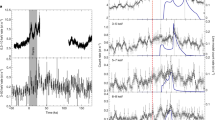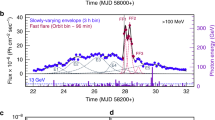Abstract
REES1 has pointed out recently that explosions of small black holes2 could be detected by the radio or optical emission from an expanding relativistic shock wave interacting with the ambient magnetic field. The frequency of the radiation is determined by the value of a parameter γf=(2×1016 g/Mcrit), where Mcrit is the mass at which the black hole explodes. Jelley et al.3 have considered the optical emission and the radio emission which will occur for γf∼105, and shown that upper limits can be set for the rate of explosions, from previous measurements at 150 and 1,700 MHz.
This is a preview of subscription content, access via your institution
Access options
Subscribe to this journal
Receive 51 print issues and online access
$199.00 per year
only $3.90 per issue
Buy this article
- Purchase on Springer Link
- Instant access to full article PDF
Prices may be subject to local taxes which are calculated during checkout
Similar content being viewed by others
References
Rees, M. J. Nature 266, 333 (1977).
Page, D. N. & Hawking, S. W. Astrophys. J. 206, 1 (1976).
Jelley, J. V., Baird, G. A. & O'Mongain, E. Nature 267, 499 (1977).
Hagedorn, R. Nuovo Cimento Suppl. 3, 147 (1965).
Porter, N. A. & Weekes, T. C. Astrophys. J. 212, 224(1977).
Author information
Authors and Affiliations
Rights and permissions
About this article
Cite this article
PORTER, N., WEEKES, T. Optical pulses from primordial black hole explosions. Nature 267, 500–501 (1977). https://doi.org/10.1038/267500a0
Received:
Accepted:
Issue Date:
DOI: https://doi.org/10.1038/267500a0
This article is cited by
-
Short-period variations of the second derivative of the gravitational potential
Astrophysics and Space Science (1993)
-
Terrestrial black holes as sources of super-high energy radiation
Earth, Moon, and Planets (1993)
-
Gamma rays and energetic particles from primordial black holes
Nature (1991)
-
Primordial black holes and spectrum of the background electromagnetic radiation
Astrophysics (1979)
-
Search for high energy γ-ray bursts from evaporation of primordial black holes
Nature (1978)
Comments
By submitting a comment you agree to abide by our Terms and Community Guidelines. If you find something abusive or that does not comply with our terms or guidelines please flag it as inappropriate.



